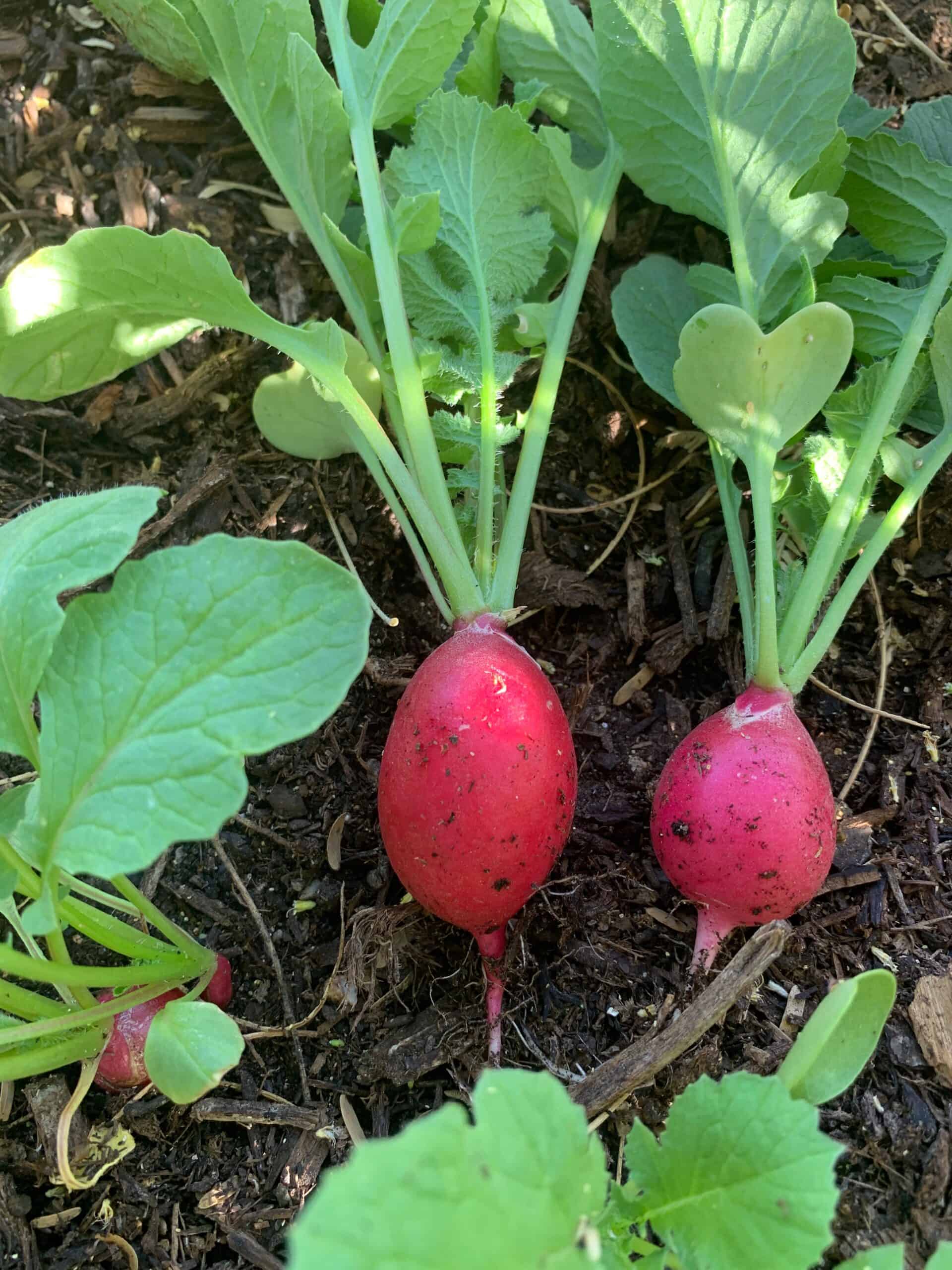Growing radishes is one of the easiest ways to start a vegetable garden. Radishes are a cool season crop. They are quick-growing, easy to plant, and require little maintenance. They are ideal for first-time gardeners.
But don’t just pick up a packet of radish seeds and start planting. There are several things to know to help ensure a successful harvest.
While seeds are relatively inexpensive, there are costs involved in gardening. The quality of the soil you have — and if you have to amend it — is a big factor. Increase your chances to grow these tips to grow radishes:
Growing Radishes
1. Choose the right variety
Radishes are very forgiving plants but it helps to plant the right variety: Early, Mid-season, or Late varieties. Plant the correct variety for the season you want to plant. Certain radish types do better in the spring versus fall and winter plantings.
2. Know your hardiness zone
Learn your growing zone. Like with everything you plant, your climate determines when you should plant radishes. Depending on where you live, you may be able to plant radish seeds in March – May for spring and September through November for a fall crop.
In moderate zones (like 9b which is the southern United States), you can grow them in the winter months as well.
3. Sow seeds directly where they are to grow
Don’t start radish seedlings indoors. As a root crop, it will be disturbed if you need to transplant it. Plant radish seeds where you want to harvest them. You can plant them in pots, containers, grow bags, garden beds, or directly in the ground. For optimum growth, plant seeds 1/4 inch deep.
4. Radishes need sun to thrive
Even though they are considered hardy cool-weather vegetables, radishes need sunlight to thrive. Avoid planting in shady spots. Partial shade is okay. Consider shade when planting with companion plants. If you grow in hot summer months (not recommended), you will want to have shade to keep the heat off them.
5. Use well-draining, fertile soil
Make sure to plant radish seeds in loose, rich soil that drains well. Once they germinate, water regularly. Irregular watering can cause the radishes to split.
Radishes are one of the most versatile vegetables you can grow in your garden. They’re easy to grow, quick to mature, and delicious raw or cooked. Learn about how to plant and grow radishes. You can eat the taproot as well as the leaves.
Early, Midseason, Late Variety Radishes
Before buying or planting seeds, be sure you plant the right type for the time of year. There are Early, Midseason, and Late varieties of radishes. You can look on the seed packet to learn the date to maturity (DTM) which is an estimation of when the radish will be ready to harvest and when to plant them.
- Early: Plant in early spring and autumn. They are fast-maturing and are ready to harvest in 20 – 30 days. Some examples are Cherry Belle, Early Scarlett Globe, and Easter Egg.
- Midseason: If you live in an area with a mild summer, you may be able to plant a summer variety. They are more tolerant of heat. In general, they tend to taste sweeter than winter radishes. The are mature in 30 – 40 days.
- Late: These are sometimes called winter radishes. You can plant in late summer through November, depending on your hardiness zone. Late varieties have large roots and take longer to grow. Their DTM is 60 – 70 days. Learn about additional winter vegetables you can grow to extend your growing season.
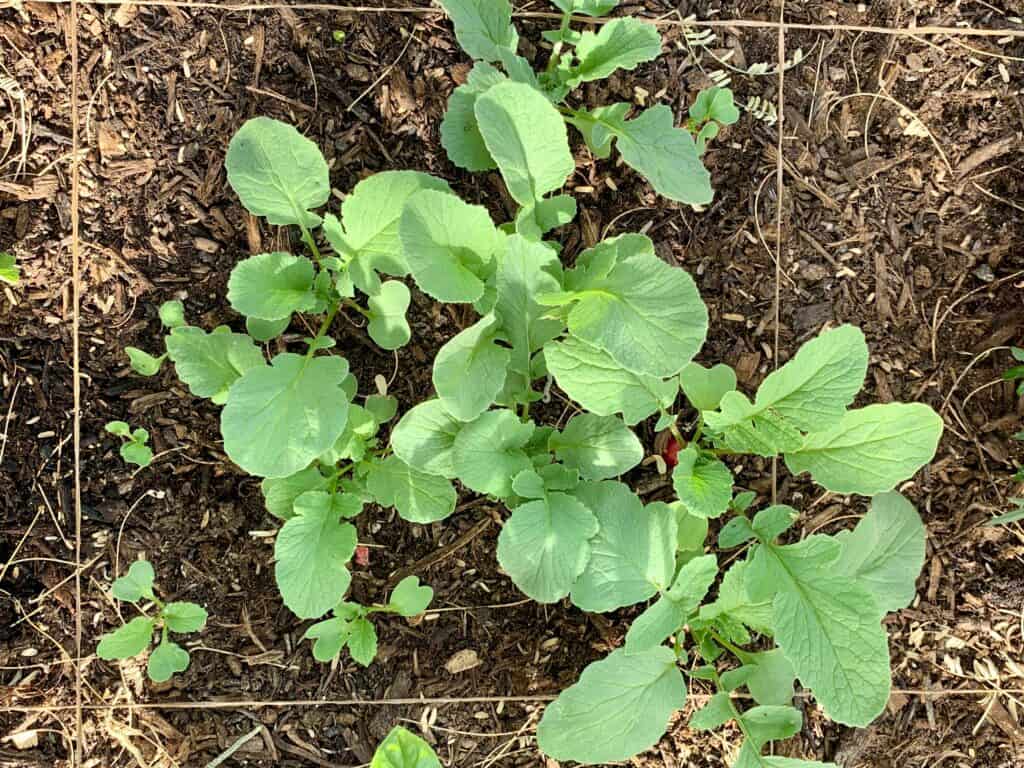
Radish Spacing
You don’t need much space for planting. Sow seeds 2 – 3″ apart for smaller varieties and 4 – 6″ apart for larger varieties.
Using the square-foot gardening method, you can plant 12 radish seeds in one square foot when growing smaller radishes. For larger radishes, plant 9 per square foot. You can also plant them in rows 10 – 12 inches apart. Sow seeds directly where they are to grow.
When to Plant Radish Seeds
Radish plants thrive in cool weather. When temperatures approach 75 – 80 degrees F, they start to bolt. It also causes the radishes to become more bitter. Plant in advance of the summer heat. Check your hardiness zone to know when your frost dates are.
- Spring planting: Sow every 2 to 3 weeks, starting 4 to 6 weeks before the last expected spring frost.
- Fall planting: Plant seeds 4 – 6 weeks before the first fall frost in your area.
Radishes are hardy and tolerate light frosts well; however, they aren’t very tolerant of hot temperatures. They do best when the temperature stays above 50 degrees F during the day and fall into the 40s at night. You can protect young radishes with a floating row cover, but older ones should be left uncovered.
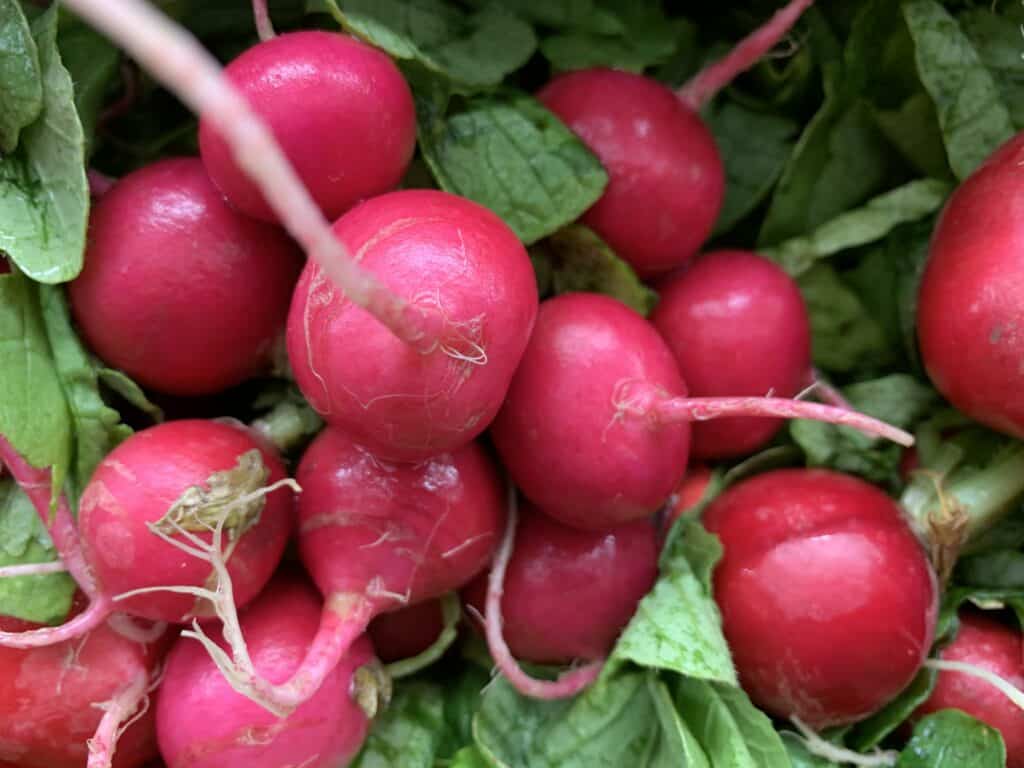
How to Grow Radishes
1. Choose the correct radish variety and type for the season you are planting in
The earlier in the year you plant, the faster the radish variety should mature. As an example, choose radish seeds that mature in 20 – 30 days when planting in March – April and seeds that mature in 60 – 70 days when planting September – November. Remember your hardiness zone.
2. Consider the soil and the location
You’ll have the most success when you plant in fertile soil. It should be well-drained, moisture-retaining and loose. Ideal pH is 6.5 – 7; however, I’ve never tested my soil and radishes have always grown well.
I amend my soil with each new planting and also rotate crops. I use a mixture of potting soil, compost, vermiculite, and peat moss. Radishes do not like excess Nitrogen.
The location should receive full sun or partial shade.
3. Sow the seeds 2 – 4 inches apart and 1/2 inch (1 cm) deep
You can soak the seeds overnight; even two hours will be helpful. It’s not essential to soak the seeds but it will help the seeds germinate faster. I have planted radish seeds without soaking them, and they grew beautifully.
4. Gently water
Water seeds after planting. Depending on how dry your area is, you may need to water every few days or once a week. They should receive around an inch of water per week, more in drier climates. Note any rainfall. Soil should drain well; radish seedlings and plants should not sit in water.
5. Watch for pests, diseases, and weeds
The great thing about Early season radishes is they grow so quickly, there isn’t much time for them to be affected by insects, diseases, or weed. Midseason and Late varieties will be more likely to be affected. Gently pull out any weeds by hand. You don’t want to dig them out because you will disturb the taproot and the roots.
I planted Early Scarlet Globe radishes from seed. They were ready to harvest in 4 weeks.Companion Plants for Radishes
- Cucumbers
- Peas
- Leaf lettuces
- Peppers
- Tomatoes
- Spinach, kale, Swiss chard, etc.
Plant early season radishes with early season vegetables or those that won’t get too large in a few weeks. You don’t want them to compete with the roots. Be sure to check maturity dates; you want to ensure companion plants won’t shade radishes.
You can grow winter cultivars with leafy greens such as spinach, arugula, romaine, and kale. Combine radishes with others on the list of the easiest vegetables to grow.
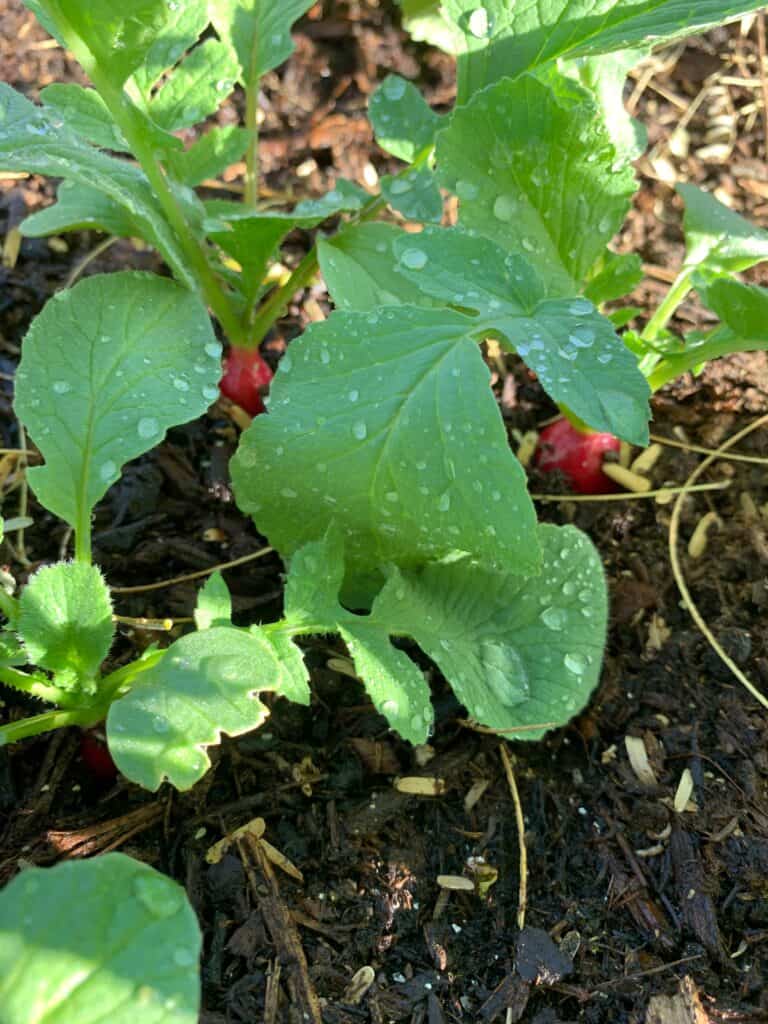
Radish Flowers
If you are trying to grow edible radishes, you don’t want flowers to grow on your radish plants. When flowers appear, the plant is bolting. Harvest the radishes immediately to preserve the root.
The longer you wait, the more bitter, peppery, and inedible it will become. You will see radish plant flowers growing when the temperatures start to get warm.
The four-petal white flowers on radish plants are bee-pollinated and will cross with other varieties of radish.
When to Harvest Radishes
- Look on seed package to get an idea of the number of days to maturity. Mark it on your calendar.
- You can pick radishes when you see them growing at soil level.
For most varieties of radishes, you know it’s time to harvest them when:
- You can see them peeking out from the soil
- Should be a minimum of around 1 inch in diameter (larger for larger varieties)
- Pick radishes when they’re firm, but still tender enough to bite into
You can pick one, wash it, and taste test it if you aren’t sure they are ready to harvest.
Once they are mature, it’s important to pick them. Harvesting radishes even just a few days after they’re ready makes them less sweet and more bitter.
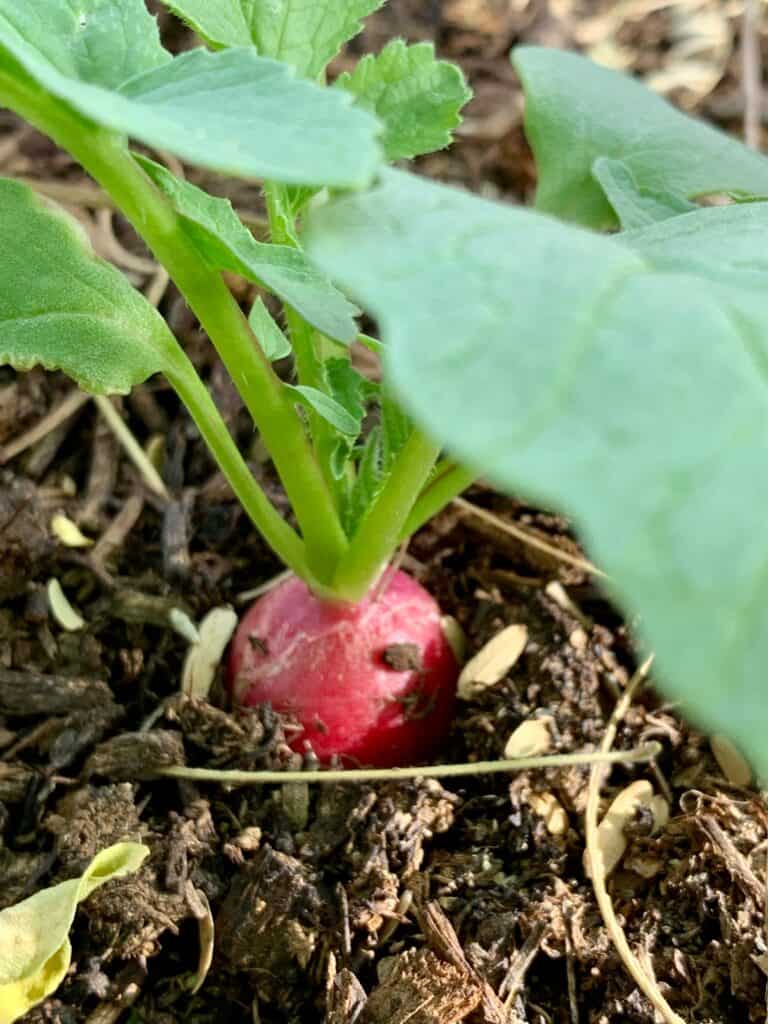
Radishes tend to dry out easily once picked. Pick them and use them as soon as you can. Keep picking frequently throughout the season once you see them at soil level. Knowing when to pick radishes is important so they don’t grow more peppery or woody.
How to Store Radishes
- Cut off radish tops and tail roots
- Wash and dry radishes
- Store them in plastic bags in the refrigerator. Put half a paper towel in the bag to catch moisture. Spring varieties will last 2 – 3 days; winter radish varieties will last a week or longer.
- Wash, dry, and store the radish leaves and greens separately
- Be sure everything is completely dry before you seal them in bags
Another option is to wipe off the dirt, and store them unwashed. Wash them when you are ready to use them.
If you want to freeze radishes, you can. Freezing will change their texture. Blanching them and then freezing them will help them freeze better.
Growing and Caring for Radish Plants
Watering
Knowing how often to water a vegetable garden is important as it’s a fine line between overwatering and underwatering. You’ll want to keep the soil moist but they should not sit in pooling water. Be sure the soil drains well. Water on a schedule if possible. Inconsistent watering can make the roots tough. Underwatering can cause radish plants to bolt. Overwatering can crack or split the radishes.
Note rainfall in your area and if you live in an arid or humid climate.
Insects and Diseases
The good news is there is a short life cycle for radishes. This means typically insects, weeds, and diseases don’t affect them as they do other garden plantings. Bringing in new soil and rotating crops between plantings and and using clean gardening tools will help prevent issues.
Radish plants can attract insects such as flea beetles, cabbage worms, aphids. These insects cause damage to the roots and bulbs of the radishes.
Diseases to watch out for include:
- Fusarium wilt
- Downy mildew
- Blackroot
- Scab
- Clubroot
Where to Buy Radish Seeds
You can buy radish seeds in local garden centers and nurseries. You can also look online for native seed companies. Local hardware stores such as ACE Hardware and home improvement stores such as Lowe’s and Home Depot will have them in their gardening sections. It’s likely Walmart will also carry them.
Also check with your local library. If you are a reader in the United States, many public libraries have a seed exchange program where local gardeners will save radish seeds (and other seeds) and donate them to the library.
Library users can check them out (and not return them). If your library has a certain radish variety, it will likely grow well in your climate.
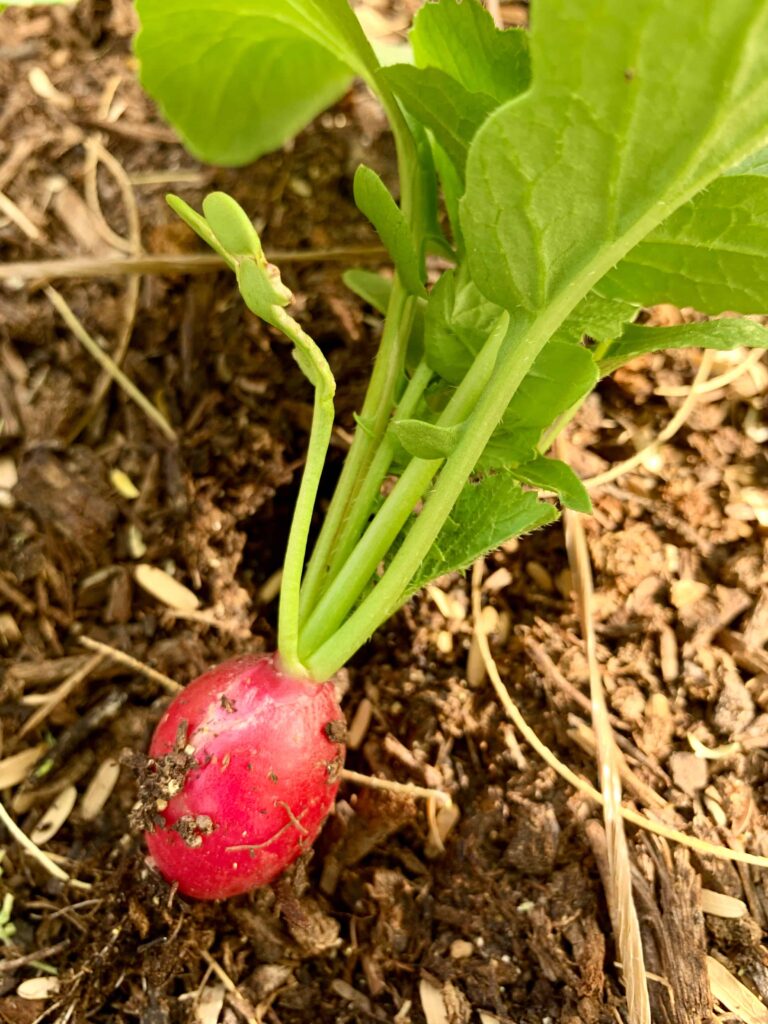
Radish Seed Storage and Viability
Store radish seeds in a cool, dry place, out of sunlight. Seeds will remain viable for 4 – 6 years when stored properly.
Watch me harvest an Early Scarlett Globe radish in AprilRadish Plant Facts
- Radishes don’t like heat; don’t plant in the summer unless you live in a climate with mild summers
- Germination: 3 – 7 days to see radish seedlings
- Pests and diseases: Cabbage root flies, cabbage worms, flea beetles, clubroot
- Yield: One taproot (radish) per plant; also can harvest edible tops and pods
- Scientific name: Raphanus sativus
Radishes are native to Eurasia. They belong to the Brassicaceae family, with cabbage and turnip. They are grown across the world for their peppery flavor. People typically eat spring cultivars raw and cook winter cultivars in stir-fries, soups, and stews. This root crop is thought to stimulate the appetite and aid digestion.
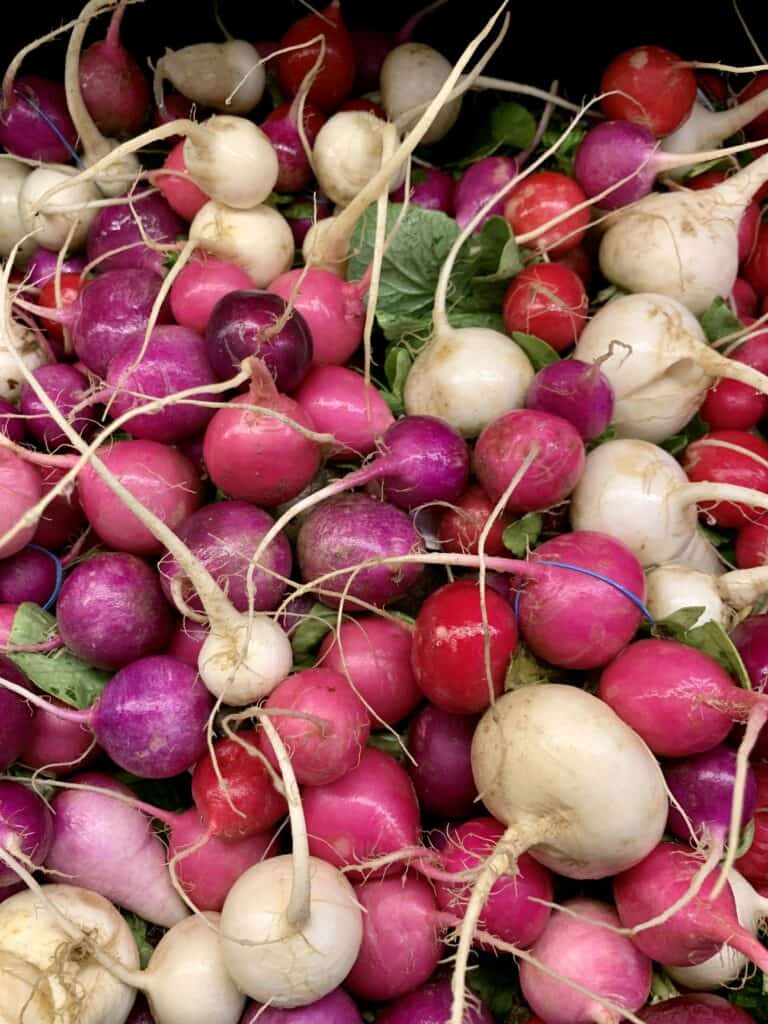
Popular Radish Varieties
Radishes come in many colors and shapes. Some are long and slender while others are short and squat. Most radishes are harvested when they’re still small and tender, and some grow into large, mature vegetables.
- Baby Red: Good for pickling and preserving. Matures in 20 days.
- Black Spanish: It’s great for salads and ready to harvest in 25 – 30 days.
- Champion: Round, red, large; 28 days to mature
- Cherry Belle: One of the easiest to grow. Red, round, popular early spring variety in home gardens. Matures in 20 – 24 days.
- Daikon: Winter radish that can grow 6 – 15 inches in length; cold hardy.
- Early Scarlet Globe: Early summer variety; globe-shaped; small and red; matures in 20 – 23 days.
- Easter Egg: Multiple colors (like rainbow mix carrots) can be white, rose, pink, purple, scarlet, etc. DTM: 25
- Fuego: 25 DTM
- French Breakfast: Somewhat heat tolerant. Oblong, red and white.
- Plum Purple: Large and round; 25 DTM
- Purple Beauty: Early spring variety; purple radish.
- Red Ace: Early spring variety that grows like a turnip or carrot. It is reddish purple and matures in 25 – 28 days.
- Red Bliss: Bright red skin; less bitter, sweet taste. Matures in 20 days.
- Snow Belle: White, round, smooth; 30 days to maturity.
- Spring Beauty: Milder tasting radish. DTM is 20 – 23 days.
- White Icicle: Late winter and early spring variety. White, long, and cylindrical. DTM is around 30 days.
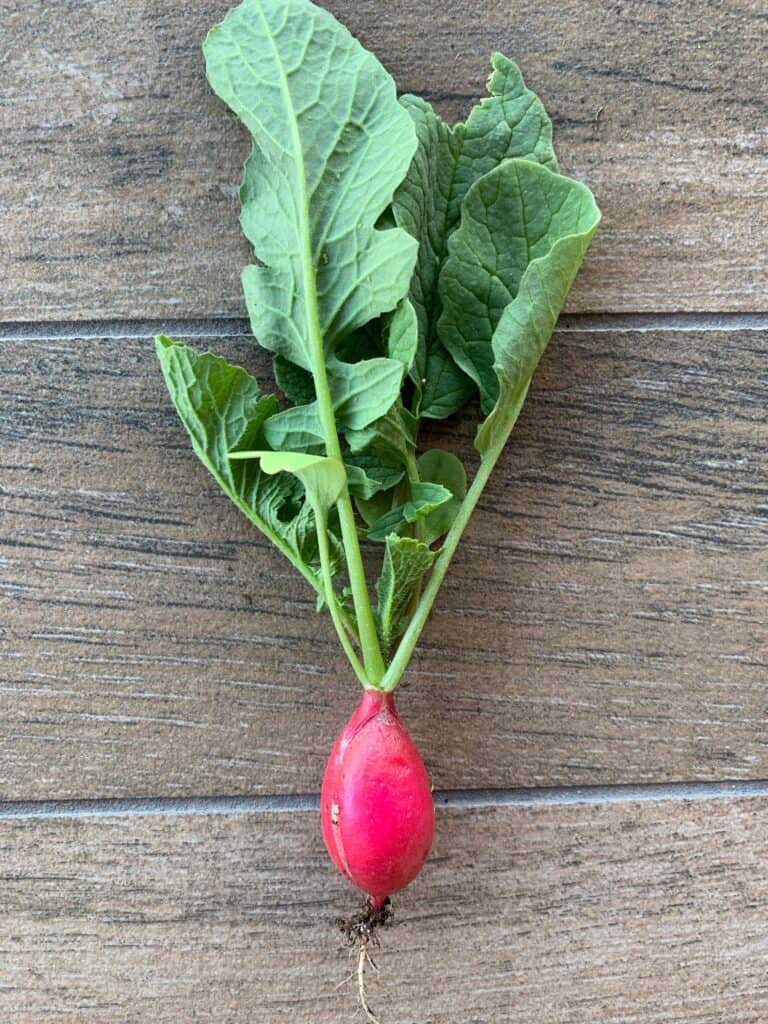
3 Radish Groups
There are categorized in these groupings:
- Radiculata: Small red, pink, and white radishes; sown in the spring
- Longipinnatus: Long white types, sometimes called mooli or daikonis; sown in winter
- Caudatum: Grown for their edible seed pods; Rattail is one variety
Serving Suggestions and Ways to Use Radishes
Hopefully you have been successful in growing radishes. Some radishes are more bitter and peppery than others. Depending on your palate, you can eat them raw or you can slice them and sauté them on the stovetop which cuts down on the bitterness.
Enjoy them raw in salads or sandwiches or cook them like other vegetables. Try grilling them whole, or slice them thinly and toss them into stir-fries and soups.
You can find radishes in most grocery stores and farmers markets. Radish plants are easy to grow, and are great for adding color and flavor to salads. They’re also versatile because they can be eaten raw or cooked. You can also eat the leaves.
How to Grow Radish FAQs
How long does it take for radishes to grow?
As one of the fastest growing vegetables, early varieties can mature in as little as 20 – 28 days, depending on the variety. Winter radishes grow larger and are ready to harvest in 60 days.
Should I start radishes indoors?
No, do not start radishes indoors. Plant the seeds outside, directly in the garden or container.
Why are my radishes blooming?
If your radishes have flowered and are blooming, this means they have bolted. They will start to produce seed. This happens when the weather becomes too warm. When radishes have bolted, the taproot won’t be very tasty. It’s best to compost them and wait for the next growing season.
Is growing radishes easy?
Yes. If you plant at the right time, space them correctly, water them regularly, and choose the correct type of radish for the time of year, you should have an almost effortless (and successful) yield.
How do radishes grow best?
Radishes need nutrient-rich soil that both retains moisture and that also drains well. Water consistently; watering irregularly can cause the radishes to split.
Do radishes need full sun?
Radishes do well in full sun or partial shade. The important thing is it’s not too hot for them. Keep in mind any companion plantings so they don’t block sunlight.
Can you grow radishes in pots?
Yes, you can grow radishes in pots. If it isn’t deep — it should be a minimum of 6 inches deep — choose a radish variety that is circular like Cherry Belle instead of large radishes that grow long, like Daikons. However, if you have a deep pot, you can grow any variety.
In addition to growing radishes in pots and containers, you can grow them in grow bags, garden beds, or right in the ground if the soil is fertile.
How long can you save radish seeds?
When stored away from temperature fluctuations and direct sunlight, seed viability is 5 to 10 years.
Can I grow radishes in the fall and winter?
Radishes are a good root crop to grow in the fall as temperatures cool. In certain regions with mild winters, you can also grow radishes in the winter. Learn about fall and winter vegetables to grow for an abundant harvest in home gardens.
Growing Radishes in Gardens, Pots, Containers, Grow Bags
Radishes come in different shapes, colors and sizes. Some are small and sweet while others are large and pungent. They’re easy to grow and require little care. With fertile soil and sunlight, you can grow radishes in garden beds, containers and pots, and in grow bags.
If you’ve never tried growing radishes, give it a try. They are ideal plants for first time gardeners and those who think they don’t have a green thumb. Kids will also delight in planting this fast-growing crop. They will be able reap the radishes in 20 – 30 days if you plant an early season variety.
Radishes don’t require much space so you can grow a lot in a small area. They don’t require much water once established. You can plant them directly into soil or in containers. Radish seeds germinate best in cool temperatures. Depending on your hardiness zone, this will likely be sometime in the spring and in the fall.

